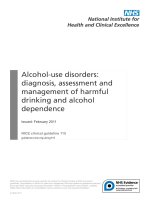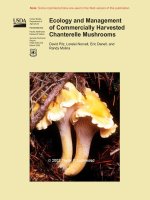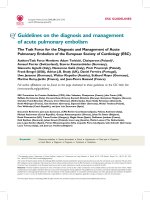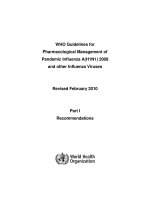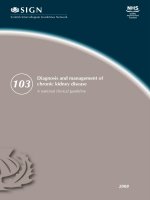Management of Brinjal shoot and fruit borer (Leucinodes orbonalis Guenee) using eco-friendly ipm strategies in farmer’s fields of Krishna district of Andhra Pradesh, India
Bạn đang xem bản rút gọn của tài liệu. Xem và tải ngay bản đầy đủ của tài liệu tại đây (238.24 KB, 8 trang )
Int.J.Curr.Microbiol.App.Sci (2019) 8(1): 2254-2261
International Journal of Current Microbiology and Applied Sciences
ISSN: 2319-7706 Volume 8 Number 01 (2019)
Journal homepage:
Original Research Article
/>
Management of Brinjal Shoot and Fruit Borer (Leucinodes orbonalis
Guenee) Using Eco-Friendly IPM Strategies in Farmer’s Fields of
Krishna District of Andhra Pradesh, India
P. Sudha Jacob1* and Revathi2
1
Krishi Vigyan Kendra, Ghantasala, Andhra Pradesh, India
S V Agricultural College, Tirupati, Andhra Pradesh, India
2
*Corresponding author
ABSTRACT
Keywords
Brinjal, Shoot and
fruit borer, IPM,
Pheromone traps,
Yield and Net
income
Article Info
Accepted:
14 December 2018
Available Online:
10 January 2019
On farm trials in ten locations were conducted to evaluate efficacy of eco-friendly IPM
strategies with emphasis on use of pheromone traps for management of brinjal shoot and
fruit borer (Leucinodes orbonalis Guenee) and to create awareness among the farming
community on brinjal fruit and shoot borer management during rabi, 2014-15 to 2017-18
in the farmer’s fields in Krishna District of Andhra Pradesh. By adoption of eco-friendly
IPM practices in all the four years, the shoot damage was reduced on an average by 4.02
per cent compared to 9.19 per cent in farmers practice. The fruit damage on an average
was also reduced by 16.42 per cent compared to 31.55 per cent in farmers practice. The
total moth trap catches per trap per season on an average was 86.64 helping in reducing the
pest load, damage and enabled in correct decision making in application of insecticides.
This has resulted in reduction in the average cost of cultivation by Rs. 17089.00 per
hectare and the average net income was improved by Rs. 51009 per hectare compared to
the farmers practice. The average yield levels improved by 12.94 per cent compared to
farmers practice (35.7 qt/ha) and giving a clear message that adoption of IPM practices
with emphasis on pheromone traps helped in reducing the pest levels, damage and
improving yield; helps in improving the decision making capacity and net income levels to
the resource poor farmers.
Introduction
Brinjal eggplant (Solanum melongena L.) is an
important, highly cosmopolitan and popular
vegetable grown as poor man’s crop in India.
It contributes 8.3 per cent of the total
vegetable production of the country. In India,
area under brinjal cultivation in 2013-14 was
0.71 million ha with productivity of 19.1 t/ha
and in Andhra Pradesh, it is cultivated in
0.058 million hectare with productivity of 20.0
t/ha (Indian Horticulture database, 2015).
Different insect pests attack brinjal from the
time of planting till its harvest. Some
important insect pests are brinjal shoot and
fruit borer (BSFB) (Leucinodes orbonalis),
coccinellid
beetle
(Epilachna
vigintioctopunctata), leafhopper (Amrasca
2254
Int.J.Curr.Microbiol.App.Sci (2019) 8(1): 2254-2261
bigutulla bigutulla), aphid (Aphis gossypii)
and whitefly (Bemisia tabaci) (Latif et al.,
2009).
Among the various pests which hinder the
realization of the yield potential, the most
destructive and serious pest is brinjal shoot
and fruit borer (BSFB), L. orbonalis Guenee
(Lepidoptera: Pyraustidae) (Latif et al., 2010;
Chakraborti and Sarkar, 2011). It is
monophagous and remained a major pest of
brinjal in all growing areas (Dutta et al.,
2011). The pest is more prevalent in areas
having hot and humid climate (Srinivasan,
2009). The yield losses may reach up to 85 to
90 per cent (Misra, 2008; Jagginavar et al.,
2009).
The larva soon after emergence causes dead
hearts by boring into the petiole and midrib of
leaves, tender shoots (CABI, 2007; Alpureto,
1994 and AVRDC, 1998). On appearance of
the flowers and fruits in the later stages, the
larvae cause severe loss to the economic parts.
The larvae, after hatching, bore inside fruit
and the minute entrance hole is closed by the
excreta of feeding larvae (Alam et al., 2006).
But once fruit setting is initiated, shoot
infestations become negligible (Kumar and
Dharmendra, 2013) or completely disappear
(Naqvi et al., 2009). Larvae feed on the
mesocarp of fruit and the feeding and
excretion result in fruit rotting (Neupane,
2001), making it unfit for human consumption
(Baral et al., 2006). On an average, a larva can
infest 4 - 7 fruits during its life span (Jayaraj
and Manisegaran, 2010). Infestation by this
pest results in lowering the vitamin C content
up to 80 per cent in infested brinjal fruit
(Sharma, 2002).
Since this pest is an internal feeder,
formulating an adoptable management
strategy on a wider scale is a difficult task.
Even though several cultural measures were
developed for containing this monophagous
pest, no single measure is sufficient to
efficiently manage this pest to a satisfactory
level and thus farmers rely highly on chemical
pesticides owing to their ease in adoption and
adoptability in wider areas with varied
frequency of application to produce damage
free marketable produce.
Nearly 90% of the Indian farmers apply
chemical pesticides in brinjal cultivation and
the number of pesticide sprays range from 10
to 28 thus, spending a significant part of the
cost of cultivation mainly towards chemical
pesticide-based
plant
protection.
Paradoxically, the brinjal farmers in India are
resource poor and mainly belong to small,
medium and marginal groups, who depend on
this crop as an important source of income.
This contradictory and opposing scenario of
poor farmers extensively spending on
chemical control of BSFB is a serious concern
which demands urgent intervention by modern
biology to mitigate the problem of BSFB
(Vageesh babu et al., 2014). The current
strategy of farmers is not only non-sustainable
but, if continued, it will adversely affect
consumers and the profitability of farmers
threatening its cultivation.
Since employment of single strategy led to
several adverse effects with variable efficacy
levels, promotion of adoptable strategies in an
integrated approach is the need of the hour to
contain the monophagous internal borer. Such
integrated pest management practices need to
be promoted for adoption at field level on a
wider scale with less reliance on pesticides.
Use of pheromone traps for monitoring and
mass trapping in combination with other
techniques to bring down pest infestations can
help in ensuring growth of healthy crops.
Thus, an attempt was made to evaluate use of
pheromone traps as major component of IPM
with other techniques for the control of L.
orbonalis in the farmers’ fields.
2255
Int.J.Curr.Microbiol.App.Sci (2019) 8(1): 2254-2261
Materials and Methods
The present investigation was carried out in
the farmers’ fields of adopted villages of
KVK, Ghantasala in Mopidevi mandal of
Krishna district for four years from 2014-15 to
2017-18, where farmers cultivate brinjal in
large area during rabi season. On farm trials
were conducted in 10 selected farmers’ fields
with an objective to evaluate the performance
of integrated pest management practices with
emphasis on the use of pheromone traps for
monitoring and mass trapping of brinjal fruit
and shoot borer so that the same package may
be popularized among the farming community
with less dependence on pesticides.
T1: IPM with emphasis on use of pheromone
traps
Collection and destruction of infested plant
parts
inner surface of a plastic tube, when baited in
a suitable trap and placed in the field can
attract male moths continuously for up to 6
weeks (Talekar, 2002). The lures were
changed at an interval of 45 days as
recommended. Insecticides viz., profenophos,
novaluron, flubendiamide and thiodicarb were
sprayed at recommended doses for
management of the pest infestation and fruit
damage.
The data on infested shoot was recorded by
direct count but percentage of infested fruits
was calculated by using the following
formula. For calculating the fruit infestation
and yield per hectare, fruits after harvesting,
the healthy and infested fruits were sorted out.
The weight of healthy and infested fruits of
each plot for each treatment was noted
separately. The percent fruit infestation was
calculated using the following formula:
Number of infested
fruits
Number of total
fruits
Use of pheromone traps @ 50/ha for
monitoring and mass trapping of male moths
Need based application of insecticides
% Fruit infestation
=
T2: Farmers practices (Non IPM)
Results and Discussion
Use of only insecticides for management of
BSFB
The results indicate (Table 1) that adoption of
IPM module with emphasis on collection and
destruction of infested plant parts viz., infested
shoot in the early stages of the crop growth
and damaged fruits in the later stages helped
in reduction of pest population buildup and
thereby the shoot and fruit damage. Farmers
prefer high yielding private hybrids for getting
higher net returns, which are fast growing,
fertilizer responsive and less tolerant to pest’s
infestation. In 2014-15 in the IPM plot, the per
cent shoot damage was 4.67 per cent while,
fruit damage was 10 and in the farmers
practice it was 10.8 per cent followed by 38
per cent, respectively, wherein only chemical
insecticides were sprayed indiscriminately. In
IPM plot, the fruit yield was 329.5 qt/ha with
a 13.8 per cent increase over farmers practices
Each treatment was imposed in 0.4 Ha with
brinjal MHB-52 and US-172 hybrids.
Recommended package of practices were
followed for raising the crop. For monitoring
and mass trapping of male moths of BSFB, 50
WOTA traps with lucin lures (supplied by
Pest Control India, Bangalore) were used at
equal distance in the field. The traps were
installed 30 days after transplanting of brinjal
at 30cm above the crop canopy. The traps
were fixed on bamboo poles. The pheromone
of BFSB consists of a mixture of (E)-11hexadecenyl acetate and (E)-11-hexadecen-1ol, in a mixture of 10:1 to 100:1. Pheromone
sample of 2-3 mg were impregnated on the
2256
×
100
Int.J.Curr.Microbiol.App.Sci (2019) 8(1): 2254-2261
(289.5 q/ha). In 2015-16 in the IPM plot, the
per cent shoot damage was 3.12 per cent
while, fruit damage was 13 and in the farmers
practice it was 7.87 per cent followed by 25
per cent, respectively. In the IPM plot, the
fruit yield was 350.5 qt/ha with a 12.3 percent
increase over farmers practices (312 q/ha). In
2016-17 in the IPM plot, the per cent shoot
damage was 4.96 per cent while, fruit damage
was 20.2 and in the farmers practice it was 9.2
per cent followed by 34.2 per cent,
respectively. In the IPM plot, the fruit yield
was 213 qt/ha with a 14.4 per cent increase
over farmers practices (186.25 q/ha). In 201718 in the IPM plot, the per cent shoot damage
was 3.34 per cent while, fruit damage was
16.5 and in the farmers practice, it was 8.9 per
cent followed by 29 per cent, respectively. In
the IPM plot, the fruit yield was 337.5 qt/ha
with a 11.25 per cent increase over farmers
practices (300 q/ha).
Pheromone trap catch of adult male moths
of brinjal shoot and fruit borer, L. orbonalis
Pheromone traps were used in the IPM
module to trap the adult moths present in the
crop environment to prevent the egg laying, so
that the buildup of the pest population and
subsequent infestation to the shoots and fruits
can be minimized with much less use of
chemical insecticides. In the present
investigation pheromone traps @ 50/ha was
used and results indicate that the use of
pheromone traps not only helped in
monitoring the pest status but also helped in
attracting large number of male moths and in
reducing the pest damage in all the years.
Monitoring of moth activity can be used as a
source of information to initiate pest
management practices (Fig. 1 and 2).
Table.1 Details of the brinjal crop yields obtained and shoot and fruit damage
Year
Variety
2014-15 US -172
2015-16 US - 172
2016-17 US -172
2017-18 MHB-52
No. of
Farmers
10
10
10
10
Yield (q/ha)
Demo
329.5
350.5
213.0
337.5
Check
289.5
312.0
186.25
300.0
Increase
in yield
(%)
13.8
12.3
14.4
11.25
Per cent shoot Per cent fruit
damage
damage
Demo Check Demo Local
4.67
10.8
16.0
38.0
3.12
7.87
13.0
25.0
4.96
9.2
20.2
34.2
3.34
8.9
16.5
29.0
Table.2 Details of cost of cultivation, average gross and net income levels
Year
Average Cost of
Average Gross Return
Average Net Return
BC ratio
cultivation (Rs./ha)
(Rs./ha)
(Profit) (Rs./ha)
Demonstration Local Demonstration Local Demonstration Local Demo Local
Check
Check
Check
Check
127500
132500
442575
409500
315075
277000 3.47
3.34
2014-15
133575
148950
466575
412520
333000
263570 3.49
2.76
2015-16
2016-17
129500
162580
394050
372500
264550
209920
3.04
2.29
2017-18
119225
134125
267000
240000
147775
105875
2.24
1.79
2257
Int.J.Curr.Microbiol.App.Sci (2019) 8(1): 2254-2261
Fig.1 Graph showing the relationship between pheromone trap catches and damage levels
Fig.2 Graph showing the pheromone trap catches week wise
Yousafi et al., (2016) reported that combined
regression of moths and fruit infestation
during 2012 and 2013 revealed that 19 moths
caught in 15 days will result in a 10 per cent
fruit infestation which is the ETL for BSFB.
The moth catch recording was started from 1st
week after their installation in the field and
continued throughout the fruiting period of
the crop upto 16 weeks from their installation.
In 2014-15, the average total moth catch per
trap was 91.80 with peak catch in 6th week
after installation of the traps, while, it was
80.95 in 2015-16 with peak catch in 7th week
and in 2016-17 it was 94.56 with peak catch
in 5th week and it was 79.24 in 2017-18 with
peak catch in 6th week. Different workers
have reported a positive correlation between
lepidopteran larval infestation and adult
2258
Int.J.Curr.Microbiol.App.Sci (2019) 8(1): 2254-2261
catches in traps (Knight, 2001; Walker et al.,
2003; Martin et al., 2011). Khalique and
Feeroza (2012) studied the relationship
between the number of trap catches of
Helicoverpa
armigera
and
chickpea
infestation and concluded that this study
helped in designing IPM strategy well in time.
time for pest management. Amin and Gergis
(2006) suggested that the integration of
lepidopteran moth monitoring with other
insect pest control methods can improve
environmentally friendly management of
insect pests in cotton.
References
The cost of cultivation, average gross returns,
average net returns and benefit cost ratios
calculated in each year were presented in
table 2 indicates that adoption of eco-friendly
IPM practices resulted in reduction of number
of sprays of insecticides, thus reducing the
cost of cultivation and improving the net
income levels. In 2014-15, through adoption
of IPM practice, the cost of cultivation was
reduced by Rs. 5000.00 with an increase of
Rs. 38075.00 in net returns compared to the
farmers practice, the benefit cost ratio was
3.47 compared to 3.34 in farmers practice. In
2015-16, the cost of cultivation was reduced
by Rs. 15375.00 with an increase of Rs.
69430.00 in net returns in IPM plots
compared to farmers practice. The benefit
cost ratio was 3.49 compared to 2.76 in
farmers practice. In 2016-17, the cost of
cultivation was reduced by Rs. 33080.00 and
an increase of Rs. 54630 in net returns in IPM
plots compared to farmers practice. The
benefit cost ratio was 3.04 compared to 2.29
in farmers practice. In 2017-18 also, the cost
of cultivation was reduced by Rs. 14900.00
with an increase of Rs. 41900.00 in net
returns in IPM plots compared to farmers
practice. The benefit cost ratio was 2.24
compared to 1.79 in farmers practice. The
data indicates that by adoption of IPM
practices with emphasis on pheromone traps,
decision making can be done correctly with
respect to the application of insecticides, thus
avoiding unnecessary sprays leading to
reduction in pest management cost and
improving the net returns. Ramamurthy et al.,
(2010) observed that the analyses of catches
in traps are helpful in suggesting appropriate
Alam, S.N., Hossain, M.I., Rouf, F.M.A.,
Jhala, R.C., Patel, M.G., Rath, L.K.,
Sengupta, A., Baral, K., Shylesha, A.N.,
Satpathy, S., Shivalingaswamy, T.M.,
Cork, A. and Talekar, N.S., 2006.
Implementation and promotion of an
IPM strategy for control of eggplant
fruit and shoot borer in South Asia.
Tech. Bull. 36. AVRDC
Alpuerto, A.B., 1994. Ecological studies and
management of brinjal fruit and shoot
borer, Leucinodes orbonalis Guenee.
Ind. J. agric. Sci., 52: 391-395.
Amin, A.A. and Gergis, M.F., 2006.
Integrated management strategies for
control of cotton key pests in Middle
Egypt. Agron. Res., 4 (Special issue):
121-128.
AVRDC, 1998. Annual Reports. Asian
Vegetable Research and Development
Center, Shanhua. Taiwan. Pp. 148.
Baral, K., Roy, B.C., Rahim, K.M.B.,
Chatterjee, H., Mondal, P., Mondal, D.,
Ghosh, D. and Talekar, N.S., 2006.
Socio-economic parameters of pesticide
use and assessment of impact of an IPM
strategy for the control of eggplant fruit
and shoot borer
CABI, 2007. Crop protection compendium.
CAB International. (Available at:
http://www. cabicompendium.org/cpc).
Chakraborti, S. and Sarkar, P.K., 2011.
Management of Leucinodes orbonalis
Guenee on eggplant during the rainy
season in India. J. Protect. Res., 51:
325- 328.
Dutta, P., Singha, A.K., Das, P. and Kalita, S.,
2259
Int.J.Curr.Microbiol.App.Sci (2019) 8(1): 2254-2261
2011. Management of brinjal fruit and
shoot borer, Leucinodes orbonalis in
agro-ecological conditions of West
Tripura. Scholarly J. agric. Sci., 1:1619.
Indian Horticulture database, 2015 National
Horticultural Board, Ministry of
Agriculture, Govt. of India, 127-135
Jagginavar, S.B., Sunitha, N.D. And Biradar,
A.P.,
2009.
Bioefficacy
of
Flubendiamide 480C against brinjal
fruit and shoot borer, Leucinodes
orbonalis Guen. Kamtaka J. agric. Sci.,
22: 712-713.
Jayaraj, J. and Manisegaran, S., 2010.
Management of fruit and shoot borer in
brinjal. The Hindu Sci-Tech. Agri.
College and Res. Inst. Madurai.
Khalique, A and Feeroza, K., 2012.
Oviposition and larval development of
Helicoverpa
armigera
(Hübner)
(Lepidoptera: Noctuidae) in relation
with chickpea, Cicer arietinum L.
(Fabaceae) crop phenology. Pakistan
J.Zool., 44:1089-2012.
Knight, A.L., 2001. Monitoring the seasonal
population density of Pandemis
pyrusana (Lepidoptera: Torticidae)
within a diverse fruit crop production
area in the Yakima valley, Wa. J.
entomol. Soc. Br. Columb., 98: 217-225.
Kumar, S. and Dharmendra, S., 2013.
Seasonal incidence and economic losses
of brinjal shoot and fruit borer,
Leucinodes orbonalis Guenee. Agric.
Sci. Digest., 33: 98-103.
Latif, M.A., Rahmah, M.M., Islam, M.R. and
Nuruddin, M.M., 2009. Survey of
arthropod biodiversity in the brinjal
field. J. Ent., 6: 28-34.
Latif, M.A., Rahman, M. M. and Alam, M. Z.,
2010. Efficacy of nine insecticides
against shoot and fruit borer,
Leucinodes
orbonalis
Guenee
(Lepidoptera: Pyralidae) in eggplant. J.
Pestic. Sci., 83: 391-397.
Martin, G.J., Jactel, H. and Diez, J.J., 2011.
Pattern and monitoring of Sessia
apiformis infestations in poplar
plantations at different spatial scales. J.
appl. Ent., 135: 382-392.
Misra, H.P., 2008. New promising
insecticides for the management of
brinjal shoot and fruit borer, Lecinodes
orbonalis Guenee. Pest Manage. Hort.
Ecosys., 14:140- 147.
Naqvi, A. R., Pareek, B.L. and Mitharwal,
B.S., 2009. Seasonal incidence of shoot
and fruit borer, Leucinodes orbonalis
Guenee infesting in hyper arid regions
of Rajhistan. J. Insect Sci., 22: 195-198.
Neupane, F.P., 2001. Crop pest and their
management (4th ed.) (Nepali language).
Sajha Prakashan, Pulchwok. Lalitpur,
Nepal. Pp. 582.
Ramamurthy, V.V., Akhtar, M.S., Patankar,
N.V., Menon, P., Kumar, R., Singh, S.
K., Ayri, S., Kumar, S., Parveen, S. and
Mittal, V., 2010. Efficiency of different
light sources in light traps in monitoring
insect diversity. Mun. Ent. Zool., 5:
109-114.
Sharma, D.R., 2002. Bioefficacy of certain
insecticide and biopesticides against
major pest of brinjal under field
condition. M.Sc. thesis. Indian Agric.
Res. Inst. New Delhi, India, pp. 160.
Srinivasan, R., 2009. Insect and mite pests on
eggplant: a field guide for identification
and management. AVRDC Publication
No. 09-729. AVRDC – The World
Vegetable Center, Shanhua, Taiwan. 64
p.
Talekar, N.S. 2002 Controlling Eggplant Fruit
and Shoot Borer A Simple, Safe and
Economical Approach. AVRDC pub.
#02-534. International Cooperators’
Guide
Vageesh babu S. Hanur, K. Boopal, Vijeth V.
Arya, K. N. Srividya, M. S. Saraswathi
2014 Why is management of brinjal
shoot and fruit borer, Leucinodes
2260
Int.J.Curr.Microbiol.App.Sci (2019) 8(1): 2254-2261
orbonalis Guenee, difficult? An
examination into the pest’s unique
feeding behavioral biology. Journal of
Entomology and Zoology Studies, 2 (6):
257-260
Walker, G.P., Wallace, A.R., Bush, R.,
MacDonald, F.H. and Sukling, D.M.,
2003. Evaluation of pheromone
trapping for prediction of diamondback
moth in vegetable brassicas. N. Z. Pl.
Protec., 56: 180-184.
Yousafi Q., Muhammad Afzal, Muhammad
Aslam and Allah Ditta Abid. 2016.
Monitoring of Brinjal Shoot and Fruit
Borer (Leucinodes orbonalis Guenee)
Adult Populations in Brinjal (Solanum
melongena L.) Using Light Traps.
Pakistan J. Zool., vol. 48(2), pp. 333343.
How to cite this article:
Sudha Jacob, P. and Revathi. 2019. Management of Brinjal Shoot and Fruit Borer (Leucinodes
orbonalis Guenee) Using Eco-Friendly IPM Strategies in Farmer’s Fields of Krishna District of
Andhra Pradesh, India. Int.J.Curr.Microbiol.App.Sci. 8(01): 2254-2261.
doi: />
2261
